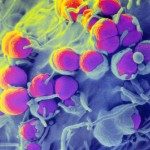Link to Pubmed [PMID] – 1684372
J. Immunol. 1991 Dec;147(12):4069-73
Most attempts to induce CTL responses by in vivo priming with free synthetic peptides have been unsuccessful so far. However, two separate studies have recently succeeded in inducing antiviral CTL responses by immunizing mice with unmodified free synthetic peptides derived from nucleoproteins from either lymphocytic choriomeningitis virus or Sendai virus. In the present study, we have analyzed the cellular mechanisms by which the lymphocytic choriomeningitis virus synthetic peptide induced CTL responses. We demonstrated that this peptide, which was previously shown to be recognized by CD8+ T cells, also contains a helper CD4+ T cell epitope. It stimulates in vivo both CD4+ T cell-mediated CTL response. The in vivo elimination of CD4+ T cells by treatment with a mAb was shown to strongly reduce the antipeptide CTL response. This study therefore demonstrates that to be able to induce CTL responses, a peptide has to stimulate both CD4+ and CD8+ T cell subset.
